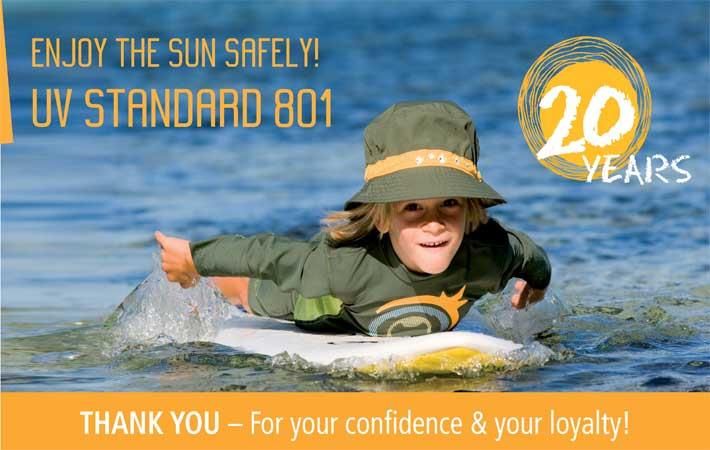Interviews
UV Standard 801 is 20 years old
19 Jan '18
3 min read

Courtesy: Hohenstein Institute
It has been 20 years since the introduction of UV Standard 801, a test process which calculates the UPF (Ultraviolet Protection Factor) and is used to specify the sun protection factor of textiles. The standard was developed in 1998 by the Hohenstein Group, the Swiss textile testing institute TESTEX and the Austrian textile research institute OETI.
The three founding members had already recognised the need for a practice-focused and significantly more realistic testing and certification of clothing and shading textiles. This is because the other methods and standards, which are still used internationally today, are limited to only testing the UV protection factor of textiles in their brand-new condition. The conditions, strains and stresses that occur with respective use are not considered in these tests.
The UV Standard 801 tests the UPF of a textile in a defined manner, even under typical usage conditions. For swimwear and sports clothings, this could be, for example, aspects like the stretching and dampening of the textile, the wear and tear caused by washing and the age of the textile. For shading textiles such as blinds, diverse weather conditions must be considered.
Only a textile that has been tested with UV Standard 801 can therefore offer reliable sun protection, even in its everyday usage condition. With textiles labelled with the UV Standard 801, consumers can thus be sure that they are purchasing high quality products and will be protected even in the “worst-case scenario”.
By using a suitable material composition and construction, that is particularly closely woven special fibres, textiles can effectively protect children’s sensitive skin from intense UV rays, for example. This is beneficial, as children only first develop their own, complete UV protection mechanisms during puberty.
When spending longer periods outdoors, prevention is generally offered - not just during sport and leisure activities. Furthermore, people who frequently work outdoors have a significantly higher risk than other professional groups of contracting so-called “white skin cancer”, which is caused by solar radiation and is officially recognised as an occupational disease. Indeed, there are already prominent, forward-thinking manufacturers that offer appropriate workwear. Yet this potential has not yet been fully exploited.
The issue of UV prevention is gaining increasing priority due to measurable and noticeable global climate change. The intensity of solar radiation is steadily increasing, even in European latitudes. Tested “clothing with integrated sun protection factor” is now no longer a niche product. Heightened consumer awareness means that the demand for effective protective measures is continuously increasing.
There are eight testing institutes throughout Europe for UV Standard 801 including one each in Portugal, Spain, France, Italy and Denmark. (SV)
The three founding members had already recognised the need for a practice-focused and significantly more realistic testing and certification of clothing and shading textiles. This is because the other methods and standards, which are still used internationally today, are limited to only testing the UV protection factor of textiles in their brand-new condition. The conditions, strains and stresses that occur with respective use are not considered in these tests.
The UV Standard 801 tests the UPF of a textile in a defined manner, even under typical usage conditions. For swimwear and sports clothings, this could be, for example, aspects like the stretching and dampening of the textile, the wear and tear caused by washing and the age of the textile. For shading textiles such as blinds, diverse weather conditions must be considered.
Only a textile that has been tested with UV Standard 801 can therefore offer reliable sun protection, even in its everyday usage condition. With textiles labelled with the UV Standard 801, consumers can thus be sure that they are purchasing high quality products and will be protected even in the “worst-case scenario”.
By using a suitable material composition and construction, that is particularly closely woven special fibres, textiles can effectively protect children’s sensitive skin from intense UV rays, for example. This is beneficial, as children only first develop their own, complete UV protection mechanisms during puberty.
When spending longer periods outdoors, prevention is generally offered - not just during sport and leisure activities. Furthermore, people who frequently work outdoors have a significantly higher risk than other professional groups of contracting so-called “white skin cancer”, which is caused by solar radiation and is officially recognised as an occupational disease. Indeed, there are already prominent, forward-thinking manufacturers that offer appropriate workwear. Yet this potential has not yet been fully exploited.
The issue of UV prevention is gaining increasing priority due to measurable and noticeable global climate change. The intensity of solar radiation is steadily increasing, even in European latitudes. Tested “clothing with integrated sun protection factor” is now no longer a niche product. Heightened consumer awareness means that the demand for effective protective measures is continuously increasing.
There are eight testing institutes throughout Europe for UV Standard 801 including one each in Portugal, Spain, France, Italy and Denmark. (SV)
Fibre2Fashion News Desk – India
Popular News
Leave your Comments
Editor’s Pick
Christian Guinet
French Textile Equipment Manufacturers’ Association (UCMTF)
Kimberly Morgan and Rik Veltman
K3 Business Technology Group PLC
































-Ltd..jpg?tr=w-120,h-60,c-at_max,cm-pad_resize,bg-ffffff)





.jpg?tr=w-120,h-60,c-at_max,cm-pad_resize,bg-ffffff)
.jpg?tr=w-120,h-60,c-at_max,cm-pad_resize,bg-ffffff)






